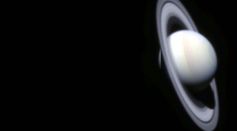Tags: Titan
Saturn Moon Titan Has San Andreas Fault-Like Tectonics, Experts Claim
Titan's Hazy Atmosphere Recreated in a Glass Jar To Reveal Mineral Composition of Saturn's Largest Moon
NASA’s Dragonfly Mission to Explore Saturn’s Moon Titan
Solar System Geological Features That You Must Know: Which One's the Most Impressive?
NASA Dragonfly Mission Releases Science Goals and Objectives on Saturn's Moon Titan
NASA New Mission Strategy: Get Samples from Saturn's Moon Titan to Uncover Its Mystery

Could Saturn's Moon Titan Give Hope for Life Beyond Earth? Here's What Scientists Say

Titan Atmosphere Simulated in Research Lead by IBM: Possible Key to Knowing Origin of Earth Life
Dragonfly Drone Would Probe Saturn's Moon Titan and Its Waters

Submarines Could Explore Largest Sea on Saturn’s Moon Titan; Can You Guess How Deep Kraken Mare Is?
Titan: Saturn's Mysterious Moon May Have the Largest Lake
What’s Causing the Tilt on Saturn’s Rotation Axis?
NASA Scientists Found An Unexpected Molecule in Atmosphere of Saturn’s Largest Moon
Next Generation Travel: Direct Fusion Drive Can Get Spacecrafts to Titan in Two Years

NASA Pushes the Dragonfly Back Another Year Due to "External" Factors

Concept Submarine May Explore Titan's Seas by the 2030s

Engineers from the European Space Agency Solves the Huygens Probe Mistery
Titan Expedition: Will NASA Find Life There?
Saturn's Moon Titan Is More Like Mars Not Earth
Cassini Approaching For Its Final & 127th Flyby Towards Titan [Watch]
Most Popular

Space Tourism Future: How Commercial Space Travel Will Transform Civilian Exploration

Universe Origin Revealed: Exploring the Latest Big Bang Science Theories and Discoveries

How Space Observation and the Solar Light Spectrum Make the Sun Look Different in Space Than on Earth

What Causes Tornadoes and How They Form: Tornado Science Explained for Extreme Storms





